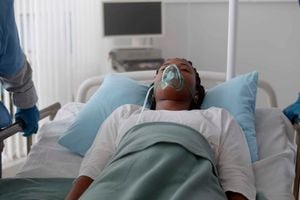Lessons from Kenyans who are facing amputation
What you need to know:
- Diabetes is one of the leading causes of amputations
- 40% - Only 40 percent of Kenyans are currently on treatment and follow-up
- 87% - More than 87 percent of Kenyans have never had their blood sugar measured
7.39 a.m.
A pungent smell overwhelms the morning breeze as we make our way through hundreds of Kenyans from all walks of life who have braved the cold to seek treatment at Lions Foot and Wound Care Clinic in Loresho, Nairobi.
“We are used to the smell; do not worry. Patients come here with very septic smelly wounds reeking of rot,” a receptionist who notices out twisted noses fills in the blanks as we sit next to a lady whose both legs are bandaged.
We are quick to notice that most people at the facility’s waiting area are bandaged, with some even using tattered clothes while others have wrapped their feet in rags with pus dripping out of them.
They have faced the possibility of losing significant portions of their limbs for various reasons.
Cause 1: Mismanaged leg injuries
“My name is Felista Nduta. I have been a patient here since June last year and were it not for these doctors, my leg would have been amputated already,” the bandaged lady starts off after we introduce ourselves.
Ms Nduta discloses that it all began when a piece of a broken glass forced its way into the sole of her right foot after piercing through her rubber shoes.
“I pulled out the broken piece of glass and went about my business as I was heading to the market. But after a week, the leg started swelling and turned reddish. After that, pus started oozing endlessly,” she says.
Because the pain was becoming too unbearable, the Thika-based shopkeeper checked herself into Thika Level 5 Hospital and was immediately put on medication. She was told it would make the pus dry out.
“After that initial visit, I did not feel any better. During a second visit, doctors recommended that I go to the theatre to be operated on. Amputation was on the surgeon’s table,” she says.
Amputation is the surgical removal of part of the body. According to Dr Shilpa Ranjan Mulki, a physician/diabetologist who heads the foot and wound care clinic, amputation can start from chopping off the tip of the toe and move nearer to the body.
“At our centre, we try our best to prevent amputation at any cost,” says Dr Shilpa.
Amputations can be done under general anaesthesia (where a patient is unconscious) or using a method where the lower half of the body is numbed. The choice of anaesthesia depends on the body part targeted.
Once the section of the limb has been amputated, additional techniques can be used to improve the functioning of the remaining part of the limb and reduce complications.
These include shortening and smoothing the bone in the remaining section of the limb so it is covered by an adequate amount of soft tissue and muscle. The surgeon then stitches the muscle to the bones to help strengthen the remaining section (a technique known as myodesis).
For Ms Nduta, the thought of having her leg cut off was too painful to bear and so she sought a second and third opinion. That is when a friend recommended that she visits the Lions clinic.
“The recommendation came after things got worse even after the operation. The pus couldn’t stop flowing and I felt so helpless besides constantly being in so much pain. I have, however, seen progress after coming to this clinic despite parting with around Sh20,000, which includes buying the medication I need,” she says.
Like Ms Nduta, Alice Wanjiru who hails from Kiambu County is also fighting to save her right leg after stepping on an old, rusty iron nail.
“In June last year, a nail thrust into my right foot while I was working on my farm. A few days later, I went for a tetanus injection and thought all would be well. But the wound refused to heal and three months later, my leg started swelling. I was immediately taken to theatre, with doctors opting to amputate and flesh out a chunk of my inner part of the right foot,” she discloses while showing Healthy Nation the wound and scar she bears.

Alice Wanjiru, 77, points at a scar on her right foot during the interview.
America’s Centres for Disease and Control Prevention (CDC) explains that tetanus is an infection caused by a bacterium called Clostridium tetani.
“Spores of tetanus bacteria are everywhere in the environment including soil, dust, and manure. The spores develop into bacteria when they enter the body and unlike other vaccine-preventable diseases, tetanus is not spread from person to person,” it says.
The spores can get into someone’s body through broken skin, usually through injuries. While tetanus bacteria are more likely to infect certain breaks in the skin which include wounds contaminated with dirt, faeces or saliva, puncture wounds (wounds caused by an object like a nail breaking the skin), burns, crush injuries and injuries with dead tissue.
Ms Wanjiru’s wound frequently turns septic and is yet to heal since last year.
“To manage the wound, I come here every Tuesday and Friday and have to part with Sh5,000 during each visit because my National Hospital Insurance Fund (NHIF) card is not accepted,” she says.
Cause 2: Varicose veins
Ms Josephine Waweru is another Kenyan also fighting to save her legs. She has already lost a toe.
“Last year in September, after a magnetic resonance imaging scan, doctors found that I was battling what they call varicose veins. That is why they had to amputate one of my toes after it turned dark. Having varicose veins means that some of my veins are clogged up, which totally blocks blood flow,” Ms Waweru told Healthy Nation.
Dr Shilpa, who is currently treating Ms Waweru, discloses that Ms Waweru had most probably been working too much while standing up, thus predisposing her to dilated or dysfunctional veins in the legs.
When this is not taken care of correctly and on time, she says, the skin breaks down, causing a wound. Ms Waweru had such a wound.
“She left the wound untreated for a long time before coming to us. But we have been able to bring together her wound edges by about 30 to 40 percent over the past eight to nine weeks,” says Dr Shilpa. “After evaluating her medically to ensure that there are no problems that may prevent the wound from healing, she is now doing well.”
According to John Hopkins Medicine, varicose veins are enlarged, twisted veins that can happen anywhere in the body but are more common in the legs.
They are caused by increased blood pressure in the veins. The most likely veins to be affected are those near the surface of the skin.
Blood moves towards the heart by one-way valves in the veins. When the valves become weakened or damaged, blood coalesces in the veins, making the veins become enlarged.
“Sitting or standing for long periods can cause blood to pool in the leg veins, increasing the pressure within the veins. The veins can stretch from the increased pressure, which may weaken the walls of the veins and damage the valves,” says the institution.
Dr Shilpa says the most common symptoms of varicose veins – despite the fact that each individual may experience symptoms differently – include colour changes in the skin, sores on the legs, a rash and sensations in the legs that feel like burning or aching.
Severe varicose vein attacks may eventually produce long-term mild swelling that can result in more serious skin and tissue problems which include ulcers and non-healing sores.
Ms Waweru discloses that it all started with a burning sensation that would make her endlessly scratch her toes.
“After one month, I went to a clinic in Lang’ata after I woke up one morning and found that the smallest toenail on my right foot had completely turned black. I was then admitted for it to be amputated and was put on bed rest for eight months,” she told Healthy Nation.
According to the Centre for Vein Restoration, when oxygen and nutrients are blocked from reaching skin tissue due to the swelling of varicose veins, venous ulcers form.
These open wounds typically develop near the ankle on the inside of the leg and without medical intervention, venous ulcers may become infected or the tissue around them may gradually die, leading to gangrene that may necessitate an amputation.
“Gangrene is death of body tissue due to a lack of blood flow or a serious bacterial infection. Gangrene commonly affects the arms and legs, including the toes and fingers. It can also occur in the muscles and in organs inside the body, such as the gallbladder,” the centre says.
“A condition that can damage the blood vessels and affect blood flow, such as diabetes or hardened arteries (atherosclerosis), increases the risk of gangrene,” it adds.
Cause 3: Diabetes
Seated next to Ms Waweru in the long queue awaiting to see Dr Shilpa is Mr Shadrack Kibiru who recently lost one of his toes.

Mr Shadrack Kibiru, 62, displays his foot that is under treatment.
“As a 62-year-old, I have been battling diabetes since 1996 and I’ve always tried to manage it. But, unfortunately, in 2016 both my kidneys failed,” Mr Kibiru opens up to Healthy Nation.
“I went for dialysis for two years and in 2018, the family saw it necessary that I go to India for a transplant because I was getting weaker by the day. After I got back in 2021, my toe developed an infection. At first, I was told to regularly go for dressing for one month,” he adds.
A doctor would suggest amputating the toe.
“At a Nairobi-based hospital, a doctor told me that the toe had to be amputated. I hesitated and asked him for time to think about it. During that period, another doctor I know presented another solution to my predicament,” says Mr Kibiru. “He referred me to Lions Foot and Wound Care Clinic in November 2021 where they managed to treat it and it got healed.”
But this year, Mr Kibiru says, the second toe which is next to the one that was almost amputated got infected. The infection was now spreading to the entire leg.
“I had no choice but to go the amputation way to save my leg. But, interestingly, the clinic told me that their job is to save toes, legs and even fingers and not to amputate them. This is why a surgeon from outside was recommended. The clinic has now been managing the wound and helping me save my leg,” says Mr Kibiru.
Dr Shilpa discloses that the clinic does not only manage wounds for persons with diabetes but also other wounds that emanate from injuries and accidents.
“We get a minimum of 40 to 50 patients a day. We attend to wounds, especially among persons living with diabetes — which is why our place has a smell. If the place smells nice, it means we are not doing our work,” she says.
The medic, who was born and bred in Kenya and trained in India, explains that many persons living with diabetes overlook management of their blood sugar levels.
When this happens, she says, nerves get damaged. Nerves transmit impulses to the brain and make animals responsive to the stimuli around them.
“When a person living with diabetes has nerve damage, the protective reflexes are lost and therefore they do not feel themselves getting injured. More often, they are not told to observe their feet every day,” says Dr Shilpa. “We tend to ignore our feet and they are basically the ‘donkey’ part of our bodies as they do all the hard work but are least taken care of.”
Dr Shilpa adds that when a wound progresses into an infection, it in turn progresses into a bone infection that results in an amputation if not taken care of at the right time.
She explains that there are two things that lead to a person living with diabetes getting amputated.
One is nerve damage that leads to an ulcer. When the ulcer gets too big, it is predisposed to recurrent infections and does not heal very well. Then the infection destroys the tissue, which leads to loss of function of the limb.
“Many people regard this as a cause for amputation. But, in my view, it need not be as a lot of the time, the infection can be taken care of with antibiotic therapy,” says Dr Shilpa.
The other is loss of blood supply. If you stop watering a plant, it dries up and dies. Equally, for diabetics or persons who smoke very often among other conditions, the blood supply to distant parts of the body gets blocked.
This inhibits nutrients from reaching that part of the body which means if there is a wound, it will heal slowly.
“For blockage, a vascular surgeon can get involved and reopen the vessel or put a tube in its place so that the blood supply improves and helps the wound heal,” Dr Shilpa says.
The physician/diabetologist notes a trend of rising diabetes cases among younger Kenyans.

Dr Shilpa Ranjan Mulki, a physician/diabetologist.
“We have started consuming more of processed foods and less of natural foods. We walk less and drive or use public transport more. We like our fast foods more. So, we are now seeing younger Kenyans aged 30-40 battling diabetes,” Dr Shilpa tells Healthy Nation while urging for more sensitisation and education on non-communicable diseases like diabetes.
“We are happy we are picking this up early because it means we can get them to remission and have them change their lifestyles very early,” she added.
According to the World Health Organisation, such diseases are the leading cause of death worldwide and represent an emerging global health threat.
The expert points out that an amputation in the country costs between Sh100,000 and Sh500,000 depending on various factors.
“We have specialised wound-care dressings that reduce the amount of time to heal and prevent smaller wounds from becoming bigger. This is why we do all we can to avoid amputation.”
On NHIF, Dr Shilpa discloses that they are waiting for feedback from NHIF who they have requested to consider covering foot and wound patients.
“We are working on that aspect with NHIF and I am looking forward to a very positive feedback and I am hoping more insurance payers will be able to cover that because, so far, only Jubilee Insurance are covering our patients,” she says.





